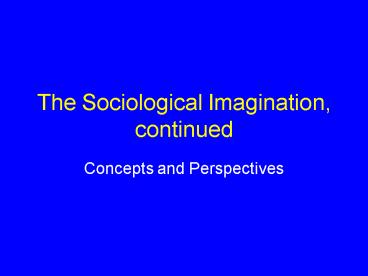The Sociological Imagination, continued - PowerPoint PPT Presentation
1 / 25
Title:
The Sociological Imagination, continued
Description:
But, American flags, flag songs, veterans groups, veterans songs ... The fact that American Indians are Indians and Americans simultaneously reflects ... – PowerPoint PPT presentation
Number of Views:121
Avg rating:3.0/5.0
Title: The Sociological Imagination, continued
1
The Sociological Imagination, continued
- Concepts and Perspectives
2
What is race?
- At one time, a group that had more physical and
moral characteristics in common with one another
than with other races. - Now, a socially constructed category of
individuals seen by society as biologically and
inherently distinct from other races.
3
The Biology of Race
- Harris How did our skins get their color?
- Graves (2002) as few as six genes out of the
total of 30-40 thousand genes could account for
skin color differences. - Brown and Armelagos (2001) no longer makes sense
to adhere to arbitrary racial categories.
4
But, outcomes are associated with race
- A higher percentage of black infants than white
infants die before reaching their first birthday. - The average number of years that an African
American can expect to live is lower than that
for a white American. - Race A socially constructed categoryreal in
its consequences.
5
What is ethnicity?
- A group characterized by cultural practices and
beliefs that distinguish them from other groups
in society? - Are they real?
- Socially constructed from within and without
Latina and Puerto Rican (J-Lo)
6
What is a minority group?
- A group of people afforded less favorable
treatment than others because of their membership
in the group. - Not all minority groups are racial and ethnic
groups. - Not all minority groups are numerically smaller
than the majority group.
7
Range of attitudes about racial and ethnic groups
other than ones own
- Relativism (extreme)
- E.G. female genital mutilation
- Dietary prohibitions (pork, alcohol, caffeine)
- Ethnocentrism
- Racism (different from prejudice)
- Where do you fit?
8
Attitudes about incorporating racial and ethnic
minorities
- Xenophobia
- Melting Pot
- Multiculturalism
- (U.S. Constitution no official language, no
official religion, now no racial criteria for
citizenship)
9
White Privilege
- What is it?
- Advantages accruing to white people in American
society by virtue of socially constructed
identities? Examples? - Racial profiling, service in stores, real estate
agents, landlords - Non-discriminators can benefit from white
privilege
10
Discrimination
- What is it?
- Denial of opportunities to members of a group
because of their group membership. - Types (Jencks, 1992)
- Principled (ethnic solidarity) Is it ok for
black businessmen to favor black suppliers but
not for white businessmen to favor white
suppliers?
11
Discrimination, continued
- Myopic (rooted in stereotypes)
- Statistical
- Institutional
12
The History of Sociological Perspectives
- 18th Century Ethnocentrismrecognition but
disapproval of cultural differences - 19th-20th Centuries Imperialism, Colonialism,
Social Darwinism, Scientific Racism - 20th Century Cultural Diversity, Cultural
Pluralism, and Cultural Relativism
13
Developing Our Sociological Imagination Taking
Stock
- Social and political acceptance of African
Americans is much greater than in the middle of
the 20th Century. - Immigration has significantly changed the racial
composition of many areas, especially large
cities.
14
Taking Stock, continued
- The Civil Rights Movement and its aftermath led
other racial and ethnic groups to focus on their
own political and economic issues. - Gender relations have changed significantly
during the past 50 years. - (Women have more choices, but many barriers
remain) - 5. Globalization
15
A Model for Understanding Contemporary Racial and
Ethnic Relations
- Important to recognize consensus and conflict
- Ignoring conflict or glossing it over is
dangerous a false or imposed consensus - Conflict carried out in the political arena is
good for our society
16
A Model,continued
- Americans can be Americans and also be,
- African, Mexican, Chickasaw, Jewish, Arab
- Maintain an interest and tie with their actual or
emotional homeland (Africa, Israel, Palestine,
Mexico)
17
American Indians as a Model for How to be an
American
- The Pow Wow
- A particularly Indian event
- But, American flags, flag songs, veterans groups,
veterans songs - Royalty modeled after beauty contests
- The fact that American Indians are Indians and
Americans simultaneously reflects the major
themes of this course.
18
Progress, Problems, and Possible Solutions
Progress
- Discarding race as a biological concept and the
explicit recognition that race and ethnicity are
socially constructed categories - Using the scientific method to study race and
ethnicity - Moving beyond an exclusive focus on blacks and
whites.
19
Current Problems
- Preoccupation with the black/white divide
- Insufficient attention to the impact of
globalization - Insufficient attention to the roles of gender and
class
20
Potential Solutions
- More research on Asians, Latinos, and smaller
understudied groups - Explicit attention to the international context
- Including gender and class in examining race and
ethnic relations
21
Historical Images
- Noble Savage
- Destructive Heathen
- Broken, Destitute Indian
- Gaming Enriched Indian
22
Contemporary Uses of These Images
- A Critique of American Society
- Dances with Wolves
- Thunderheart
- An Affirmation of American Society
- Weapons
- Mascots
- Advertising
23
Why are these images so popular?
- Extent of Popularity
- Part of common American images
- Fascinating
- Safe
- Resistance to Change Symbolic Politics
24
Are these images harmful?
- Do they perpetuate stereotypes?
- Do they impede understanding?
- Good clean fun v. respectable bigotry?
25
What Should be Done?
- Arguments Against the Continued Use of American
Indian Images - stereotypes, demeaning
- Arguments in Favor of the Continued Use of
American Indian Images - free speech, honor Indians, Indians do it
- Important to Move Beyond These Images

